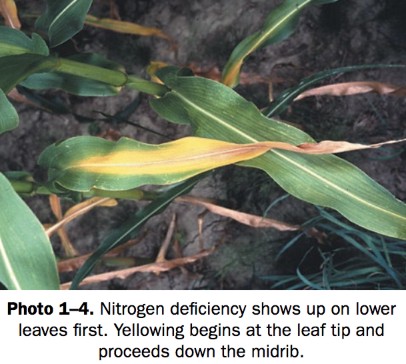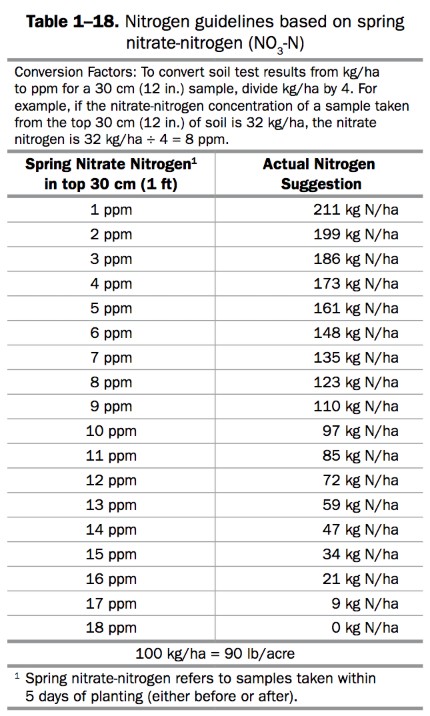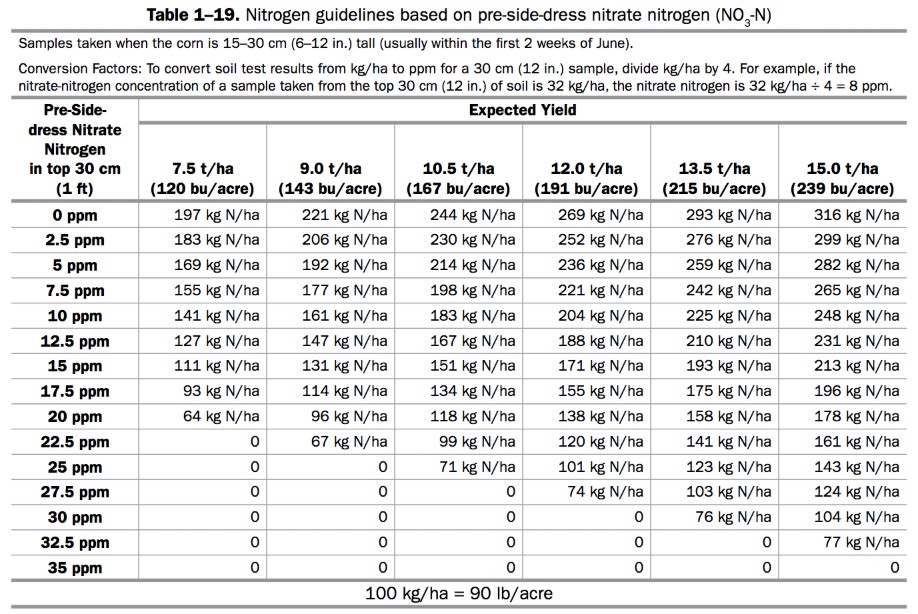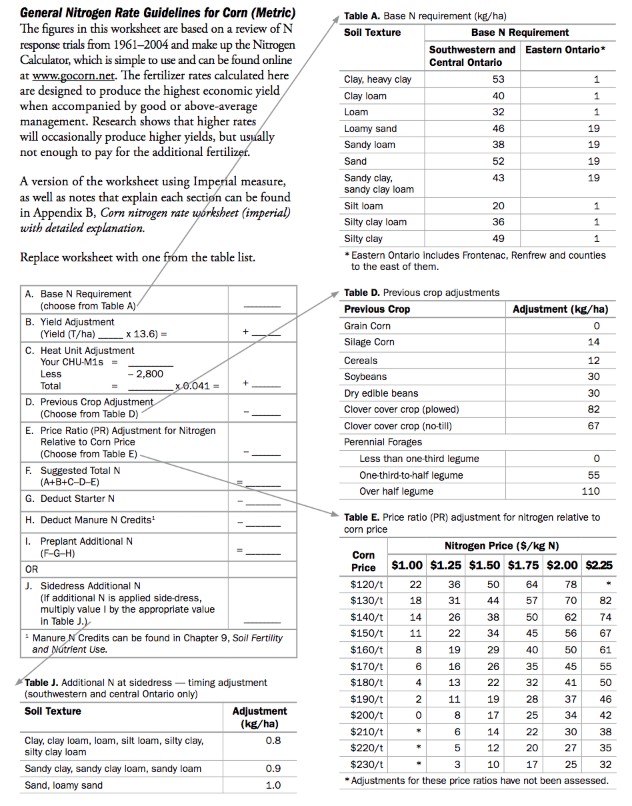Nitrogen (N)
Corn responds well to nitrogen, so adequate availability of nitrogen is critical to profitable corn production. Excess nitrogen adds unnecessary expenses and increases the risk of nitrate movement to ground water, poorer quality of surface water and production of greenhouse gases through nitrous oxide emissions. Insufficient nitrogen leads to nitrogen deficiency. Nitrogen deficiency first appears on the lower leaves, manifested as yellowing, beginning at the tip of the leaf and proceeding down the midrib (photo 1–4). Eventually, the yellow areas of the leaf will turn brown and die.

In young plants, potential yield loss will occur long before nitrogen deficiency symptoms appear, so yellowing is not a reliable indicator of the need for nitrogen fertilizers. Two methods can be used to determine optimum nitrogen rates:
1) Nitrate-nitrogen soil test.
2) General recommendations based on: expected yield, soil type, previous crop, CHU rating for
location, N fertilizer cost, corn price and application timing.
| It is common to see symptoms of nitrogen deficiency in the lower leaves as the plants near maturity, even when there is adequate nitrogen for optimum yield. |
Nitrate-Nitrogen (NO3– N) Soil Test
Soils can vary greatly in their ability to supply nitrogen. The amount of nitrate-nitrogen present in the soil at planting time, or just before side-dress, can be a useful indicator of a soil’s capacity to supply nitrogen. Use of the soil test for nitrate-nitrogen should result in a more efficient and profitable use of nitrogen as well as a reduction in the risk of nitrate movement into groundwater. Many of the factors included in the general guidelines will influence the soil nitrate levels, so the strategies for the nitrate-nitrogen soil test should be viewed as separate from the general nitrogen guidelines. Research is ongoing to fine-tune methods to incorporate the soil test results as an adjustment into the general guidelines.
Taking the Sample
Nitrates are more mobile than both phosphorus and potassium, so a separate, deeper, soil sample must be taken for the nitrate-nitrogen test. The soil should be sampled to a depth of 30 cm (12 in.). It is important that all cores in a field be taken to the same depth and that the sampling depth be included with the information sent with the sample to the lab. To ensure that the sample is representative of the field, use a sampling pattern similar to that recommended for the standard soil test, described in soil sampling. Since variations in soil nitrate content can have a large impact on nitrogen fertilizer recommendations, consider sampling more intensively for nitrate than for phosphorus or potassium. Take separate samples of:
• areas with differences in past management
• areas with distinctly different soil types
• knolls and depressions
Handling the Sample
Place soil cores in a clean plastic pail, crushed by hand and well mixed. Take about 500 g of soil (1 lb) from the pail and place it in a clean plastic bag or soil sample box. Microbial action in the sample can change the nitrate content quickly if it is not handled properly. Chill or freeze samples as soon as possible. For shipping, pack samples with insulating material to keep them cool and send them by courier to ensure quick delivery to the lab. Samples can also be air-dried. Spread the sample in a thin layer on a clean plastic sheet, breaking up any large lumps in the process. It should be dry in 1–2 days, and can be shipped to the lab without any extra precautions. Do not dry the samples in a warm oven, as this can affect the nitrate content.

Where Caution Is Required
Sometimes the fertilizer recommendations based on the nitrate-nitrogen soil test need to be modified. The nitrogen in manure or legumes applied or plowed down just before sampling will not have converted into nitrates and will not be detected by the soil test. Information will be provided with the test results on how to make appropriate adjustments. The nitrate-nitrogen soil test has not been adequately evaluated for:
• legumes or manure plowed down in the late summer or fall
• legumes in a no-till system
• soil samples taken prior to planting before the soil has warmed up significantly (i.e., in mid to
late April)
In these circumstances, use the nitrate-nitrogen soil test with caution. Table 1–18, Nitrogen guidelines based on spring nitrate-nitrogen and Table 1–19, Nitrogen guidelines based on pre-side-dress nitrate-nitrogen show the suggested application rates of nitrogen for different levels of soil nitrate-nitrogen for 30 cm (12 in.) deep samples when the nitrogen/corn price ratio is five. If the price ratio is increased to seven (i.e., the price of nitrogen fertilizer has increased or the price of corn has decreased), reduce the suggested rates by 20 kg/ha (18 lb/acre) from the rates in these tables. For more information, see price ratio adjustment, in Appendix B.

Laboratories
See Appendix C, Accredited soil-testing laboratories in Ontario, for a list of laboratories that are accredited to analyze soil samples for nitrate-nitrogen.
General Nitrogen Rate Guidelines for Corn (Metric)

This worksheet can be printed off online through the Agronomy Guide for Field Crops Pub 811 online.
Nitrogen Application
The major portion of the nitrogen should be applied in the spring as pre-plant, pre-emergence or side-dressed before the corn is 30 cm (12 in.) high. Fall application is not advised due to the potential for high losses (e.g., leaching, volatilization, runoff, nitrous oxide). A portion of the nitrogen may be applied in a band at planting. Ensure that safe rates of fertilizer near the seed are not exceeded, see agronomy guide Table 9-24, Maximum safe rates of nutrients in fertilizer. Where it is desirable to apply high rates of nitrogen at planting, it should be placed in a separate band greater than 10 cm (4 in.) from the seed row. Anhydrous ammonia, applied with conventional equipment, should be placed a minimum of 15 cm (6 in.) deep in the soil. For pre-plant applications, applicator outlets should be no more than 50 cm (20 in.) apart. For wider spacing, a 4-day waiting period before planting is recommended to avoid damage to seedlings. When appropriate equipment is used, ammonia may be applied with a cultivator or disc, a minimum of 10 cm (4 in.) deep with the ammonia outlets spaced no more than 50 cm (20 in.) apart.
Protecting Nitrogen from Loss
There are three key factors that contribute to losses of N when applied as fertilizer:
1) Volatilization from surface applied urea.
2) Early season leaching or denitrification of N when it is in the nitrate (NO3–) form.
3) Late season N losses from residual N when supply exceeds crop demand.
To reduce urea volatilization, the most common approach is to incorporate or inject the fertilizer so that soil particles trap the ammonia that might volatilize. Generally, thorough field cultivation or discing (1 pass) is enough to virtually eliminate volatilization from surface applied granular urea. If the urea source is UAN (28% or 32% solutions) the risk of volatilization is less than granular urea and in most cases a shallow tillage practice such as a vertical tillage pass can eliminate most of the volatilization risk. Additives (e.g., active ingredient NBPT) to urea that block the urease enzyme can also protect urea from volatilization losses for a significant period of time. Risk from early season leaching or denitrification is generally caused by wet soils; either sandy soils that leach N or saturated conditions that cause denitrification in heavy soils. The key strategy to reduce these two forms of loss is to reduce the size of the nitrate pool in the soil prior to any significant crop uptake. This can be done by delaying application of the N, or by using an N fertilizer product that has a slower release profile, such as coated products that physically delay the release of N or fertilizer additives that slow the conversion to nitrate. Reducing late season N losses hinges on applying fertilizer N at rates very close to the total crop demand so that post-harvest residual nitrate concentration in the soil is low.
Nitrogen Strategies
Successful nitrogen application strategies hinge on applying a rate of fertilizer N that closely matches the net difference between the N supply (soil organic matter, previous crop residues, manure, etc.) and the N demand by the crop. The OMAFRA general guidelines (see worksheet in Appendix B) for N use a significant number of factors to predict, on average, the net N requirement for a given field. Some other factors that can contribute to an improved understanding of seasonal supply and demand are:
1) total rainfall in the April 10 to June 10 period
2) CHU accumulation
3) yield potential based on plant stand and early growth
4) crop imagery (i.e., Normalized Difference Vegetative Index (NDVI) which attempts to define the colour and size of the crop and potential N status)
Producers must move away from a system where the entire N is applied in the planting window, in order to integrate seasonal inputs and general recommendations into an enhanced nitrogen strategy. An enhanced N strategy demands that planting time N applications are reduced such that there is an opportunity to make improved decisions on what rate is best for the remainder of the N supply. Split applications, where some of the N is applied at planting and the rest is applied at side-dress (V5 or later) will often reduce the total N required and improve profitability. However, the real advantage to a split application strategy does not come from simply splitting the total N rate into two unique application windows, but from splitting and making more informed rate decisions in the second application window. For example, research from the University of Guelph and OMAFRA demonstrated that in three rather unique growing seasons a strategy of 111 kg/ha (100 lb/acre) at planting followed by 56 kg/ha (50 lb/acre) at side-dress (V6) was modestly superior to a plan of applying 168 kg/ha (150 lb/acre) all at planting. Significantly better results were obtained, however, if following the 111 kg/ha (100 lb/acre) rate at planting, the side-dressed rates could be adjusted from 0–90 kg/ha (0–80 lb/acre) depending on the seasonal cues of rainfall, soil nitrates, etc. High clearance application equipment that is now more prominent in Ontario allows for applications of N to take place right up to tassel stage. This widens the window for gathering seasonal cues to determine N rates and reduces the risk of the corn getting too tall for conventional tractor drawn side-dress equipment. Research in the U.S. cornbelt has re-defined the amount of N that is taken up by the plant after VT, as illustrated in Figure 1–2, Nitrogen uptake at various stages of corn development. The need for nitrogen to be taken up by the corn plant in the post-silking window is evident. However, producers should be reminded of several
key issues that relate to late season applications:
• If nitrogen was applied earlier and has not been lost from the soil matrix from leaching or
denitrification, it will be available to feed the crop post-silking.
• So far, there is limited research that suggests any positive yield response to “newly applied
N” in the late side-dress window (V10 to tassel).
• Late applications of N that are applied to the soil surface or banded at very shallow depths
(<5 cm) may not receive sufficient rainfall to be carried into the soil matrix and be taken up
by corn roots.
• If applications are targeted to this late window, adequate N must be applied at planting to
carry the crop until the later N is applied; this might range from 67-112 kg/ha (60-100
lb/acre).

This is an excerpt of the planting section from the corn chapter of Ontario Ministry of Agriculture, Food and Rural Affair’s “Agronomy Guide for Field Crops – Publication 811”. The whole corn chapter can be viewed as PDF here. All chapters are online, and can be viewed by searching the internet for “Agronomy Guide for Field Crops – Publication 811”. Special thanks to Andrew Priest, OMAFRA summer student, for producing these Field Crop News excerpts.
